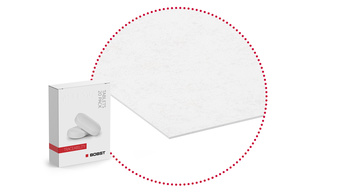Processed materials
In-line flexo folder gluers, or FFG’s, represent a complete box making solution. With close to a century of experience in the production of such equipment, BOBST is perfectly placed to deliver the machinery that corrugated packaging manufacturers around the world need.
Increasingly, RSC makers need their flexo folder gluers to deliver high quality graphics and FFG range of BOBST has been at the forefront of developing systems to achieve this, including vacuum transfer systems and the ability to handle coated boards.
Along with paying close attention to ensuring the quality of the finished product, Bobst Lyon designers have worked continuously to incorporate features which ensure ease of use and the highest possible productivity rates, especially if the boxes are destined for machine erection or are made from light weight papers.
Carton board
Carton board (also called cardboard, paperboard or solid board) is the name for a range of paper based materials that includes folding box board (FBB, GC or UC), solid bleached board (SBB, SBS, or GZ), solid unbleached board (SUB or SUS), white lined chipboards (WLC, GD, GT, or UD), some unlined chipboards, and certain laminated boards.
To manufacture carton board, fibrous material, either from trees, recycled paper, or a mixture of the two, is turned into pulp. It is then bleached and processed in a board making machine to create a board consisting of one or more layers, which may optionally be coated to provide a better surface and/or improved visual appearance.
The crossover point between paper and board is normally considered to be around 160 grams per square meter (gsm), as it is only at this level that a fibrous material is likely to be stiff and rigid enough to make a container.
Cartonboard is primarily used in the packaging industry to produce all types of folding cartons, but may also be used for graphics applications. For folding cartons the board used will normally be in the range 200 to 600gsm, or 350 to 800 microns.

Corrugated board
Corrugated board is manufactured by combining lining paper with a fluting medium in a unit called a single facer. The liners used may be made from recycled, test, or kraft papers, and will consequently have a brown or white surface, which may be coated or semi-coated, depending on the application they are to be used for. Fluting medium is generally recycled paper.
In the single facer unit, heat, steam, and a corrugating roller are used to corrugate the fluting medium, which then has the liner attached. This creates single face, the basic building block of all corrugated board. Single face is used 'as is' for some specific applications such as litho-lamination, but is normally combined with further liners and fluting media to produce single wall corrugated (single face plus a top liner), double wall (single wall plus single face), or multi-wall (further combinations of the above).
The thickness of the corrugated material will depend on the fluting height created by the single facer and the combination of flutings used. The range of thicknesses can vary from 0,5 mm for the finest, up to 15 mm for the thickest, and sometimes more. The most commonly used grammages are in the range from 80 gsm to 300 gsm, however for some specific applications lighter or heavier papers may be used.
